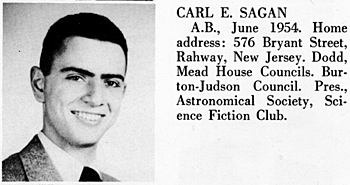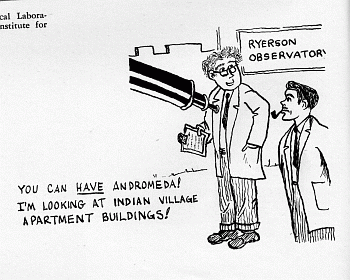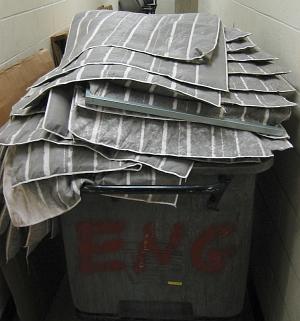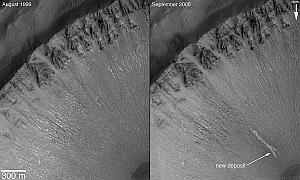A random survey across the city of Chicago reveals a surprising detail about the growth and compatibility of 802.11b/g networks: The non-overlapping channels, 1/6/11, are not at all uniformly used. Instead 70% of all networks are on channel 6, leaving 16% on channel 11, and only 5% on channel 1! I would bet that most problems associated with wireless networking nowadays have nothing to do with signal strength but rather with interference from co-channel networks. In a separate survey, in a single location, some 30+ networks were detected from inside a brick apartment building.
The survey itself was a bus ride from Midway Airport to Hyde Park via 55th street. The laptop running Netstumbler was closed and sitting in a backpack, with no attempt to improve the signal in any way. 367 networks were detected. It is clear that significant amounts of networks were not found because of the location of the antennas--a previous survey of a few blocks in a well-to-do neighborhood near the University of Chicago (Hyde Park) showed over a hundred networks with a five block walk and a sensitive USB wireless adapter.
22% of the networks did not have encryption turned on. This is not really a bad thing--you shouldn't rely on a completely broken encryption (WEP) to protect your communications. Instead, run a SSH tunnel or a VPN to ensure all communications are secure.
I suppose at this point, from the results of this look, if someone asked me for help about their wireless problems, I'd immediately tell them to switch channels on their access point. A smarter (and probably paid) consultant would scan their location and pick the least populated channel, whatever it was (and odds are it wouldn't be channel 6). That, or switch to the much less popular 802.11a, which runs at 5.8GHz.
Wednesday, December 27, 2006
Thursday, December 21, 2006
Winter Solstice
Wednesday, December 20, 2006
Carl Sagan

Carl Sagan died ten years ago today. Has it really been ten years? I guess I can say it has: new visitors to Ryerson Observatory often do not know who he was and miss some of the symbology of the one-hundred-and-six-year-old refractor they are peering through. What they don't realize is how important he was not to the advancement of science, but to public science education.
He was a student here at Chicago; he was, as the picture indicates, president of the University of Chicago Astronomical Society (now known as the Ryerson Astronomical Society). After his short stay in the college he went to the Astronomy department and left a Ph.D. I quote a visit from John Musgrave, a member of the Society, to Yerkes during Sagan's period there:
I remember the one Yerkes night we had that fall (1958): it was cloudy;
but if it had been clear we could have used any of the telescopes as no
one was using them for research - no one on staff greeted us - just some
"lowly grad students". Rather than observe we heard a lively spur of
the moment lecture by a post-doc introduced to us in somewhat apologetic
tones - "we don't know if he is for real or not" - unusual even by U of
C standards. It was Carl Sagan and he spoke about the possibility of
extraterrestrial life (maybe other things as well - but with Carl I
remember the performance more than the content - including waving
arms). I guess the "we aren't really sure about this guy" label haunted
him through to the end.
I often wonder what the dismal atmosphere of a coal-smoked Chicago was like for astronomy in the early fifties--and whether the old cranky telescope (fifty-two years old then, in 1952) did anything to inspire future thoughts. His logs are short, and there never seemed to be much observing or possibility of observing. See here for a scan of a sample logbook page. Or here for the entire text of the 1952-1964 logbook.

A member of the club in the seventies, when Sagan was back on campus showing off images of the new Viking landers on Mars, got him to sign the logbook yet again. I never met him, but a fellow RAS member at the time, Chris Conselice, was in attendance when they created a graduate student award in the astronomy and astrophysics department. He said he looked quite frail--this would have been 1995 or 96.
Keay Davidson in his biography, "Carl Sagan: A Life", writes:
And atop Ryerson Hall, he and a band of future astonomers learned (with the guidance of the astronomy club advisor, Guy C. Omer Jr.), how to operate equipment in the campus observatory. Other club members included Tobias Owen, who, like Sagan, would go on to a distinguished astronomical career. Sagan ran the astronomy club's "theoretical" section, and arranged speeches by famous professors such as Subrahmanyan Chandrasekhar.
Omer "taught me how to make the right ascension and declination drives go, and gave me a key to the observatory... and so there I was: I could go and look at the stars if ever there was a clear night in Chicago," Sagan later recalled. Yet he wasn't much of a stargazer. The club's logbooks show that Owen and several other members showed up night after night, for years, to meticulously record their observations. But Sagan observed only seven nights between October 1952 and November 1953; and when he observed, he left only terse notes. One searches the logbooks in vain for early fragments of Saganish eloquence. His most vivid entry dates from 2:15 to 3 AM on November 25, 1952, during his sophomore year: "Some [cloud] openings; then clouded over. Also COLD."
...
"Much more important" than stargazing, he later joked, was that at Ryerson Observatory, "I could bring young women to a place where could be undisturbed--which was far and away more important than being able to look through the six-inch telescope!"
In that spirit I leave you with this cartoon from the 1957 Cap and Gown. (My notes have it mislabeled as 1953--it could be 53 or 57, it matters not):

Tuesday, December 19, 2006
Radio Havana Cuba on December 18th
I offer a 30-minute recording of Radio Havana Cuba from December 18th at 8:47PM CST on 6180kHz. Reception was very good here in Chicago. I recorded this via a computer running Audacity through a Degen 1103.
Radio Havana Cuba, 2006-12-18. (30:00, 28MB, 128kb/s mp3). Includes news and music.
Radio Havana Cuba, 2006-12-18. (30:00, 28MB, 128kb/s mp3). Includes news and music.
Wednesday, December 13, 2006
Geminids tonight
If it's clear where you are, drive out into the country, get your warmest gear out, bring sleeping bags, ground pad, and a pillow--and enjoy. Tonight is the Geminid meteor shower. Unfortunately tonight I am suffering from cirrus here at Mount Hopkins in southern Arizona, but hopefully a few clear spots will give us some good viewing.
Friday, December 08, 2006
Radioactive dust on air filters

The location where I have my on-line geiger counter is certainly not dust-free: I work in a library after all, and the dust sure looks like paper dust. But the air from outside is well filtered. Since a very easy way to detect radon and its daughter products in the air is to move a large quanity of air through a filter and quickly measure the activity of the picked-up dust, I've tried this out in a variety of places. The result is no radon in my basement office (A-level), no radon in the sub-basement (B-level), but a touch of it in the server room (which has a wall directly against the subsoil).
Yesterday I got lucky: I noticed a trash bin filled with the air filters for the building and took a sample. Sure enough, the readings were elevated. Yesterday it read 11.5 uR/hr with a small piece of the filter against the counter. Today, the same sample read 8.5. (The long-term background average is 7.6).
What's not clear is what radionuclide is the source. I don't know how long the filters were sitting around before I found them. With a radon filter test, it's very important to test as quickly as possible, as you are sampling the short decays of the first four daughters formed from radon-222's decay into polonium 218. That polonium-218 has a 3.05 minute half-life, its daughter lead-214 26.9 minutes, its daughter bismuth-214 19.7 minutes, and the last polonium-214's is only 0.00015 seconds; there's not much time to get a nice graph out of it.
Since the next decay, from lead-210 into bismuth 210 has a half-life of 22 years, I'll never see it unless I had a lot of it lying around. Some researchers use Pb-210 that gets embedded in glass as a long-term measurement for radon levels in old houses.
A topical point is bismuth-210 decays into polonium-210, the poison of Alexander Litvineko which ends the uranium-238 decay chain after decaying into lead-206 (Pb-206)
The whole decay chain for U-238:

Wednesday, December 06, 2006
Recent Water on Mars

Previous post cut short--because in about linking to Phil Plait's entry about HiRISE images, I just found his link to the press release about water on Mars! Mars Global Surveyor--the one that just died recently-- took images in a southern crater that show a distinct change over the past seven years. A sudden new deposit in a gully on the crater wall.
http://www.msss.com/mars_images/moc/2006/12/06/gullies/centauri_crater/index.html
Image source: NASA/JPL/MSSS
the post-Thanksgiving update
I've been out of acceptable internet access for a week, thanks to broadband company that failed to realize their base stations are critically vital for their network to run. What they save in having no miles of wire and no maintenance of that network needs to be used to keep the base radio stations up and running. If equipment goes down, they need to have replacements available.
But anyways, I see that HiRISE imaging is going smashingly--they have picked up Spirit and Viking 1:
But anyways, I see that HiRISE imaging is going smashingly--they have picked up Spirit and Viking 1:
Subscribe to:
Comments (Atom)
